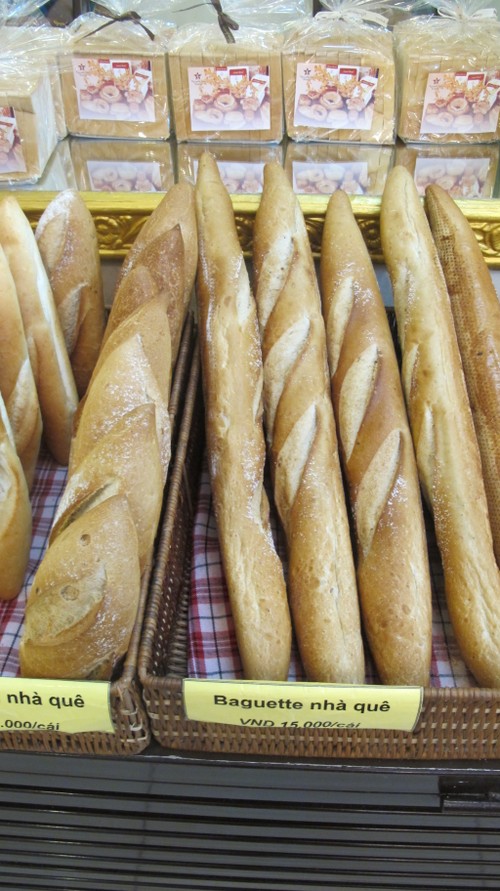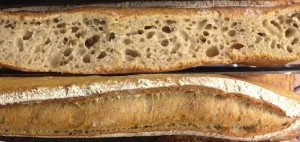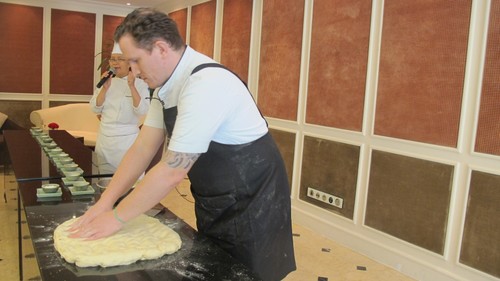(VOVworld) - Bread baguettes are very common in France as well as in Vietnam. The secret behind a scrumptious baguette with a perfect crispy crust and soft interior is a natural yeast leaven, the traditional French technique for making baguettes which has been handed down from generation to generation in France. Today we’ll introduce to you this special type of French bread and techniques for making it.
The baguette is a French specialty. The bread was initially served only for royal meals and was considered a very sophisticated dish. Baguettes were one of the main demand of the French Revolution, which stated that everyone has bread to eat. Ms. Nguyen Thanh Van, Executive Sous Chef at the Sofitel Legend Metropole Hanoi, who has 22 years of experience in the hotel’s French kitchen, talked to us about baguettes: "The word baguette, in French, means ‘chopstick’, which originates from the bread’s oblong shape. The size of the baguettes can vary according to different bakeries’ regulations. Normally, the length of a traditional baguette bread ranges from 50-80cm, and its width from 6-7 cm. There is also the mini-baguette, only 10-12 cm long, or 20-25 cm long. The width of a mini-baguette is 2-3 cm, with 2 sharp tips. Mini baguettes have exactly the same ingredients as traditional baguettes and are called “flutes”. When served, a baguette is sliced into many shuttle-shaped pieces. Mini baguettes, however, are unsliced. On every French family’s kitchen table, sliced traditional baguettes and some mini baguettes, are an indispensable part of the meal. They are sometimes arranged in a breadbasket".
 |
| French baguettes sold at Nguyen Son Bakery at Phan Boi Chau St, Hanoi (Photo: VOV / Quynh Hoa) |
The traditional technique for making French bread is to use a natural yeast leaven. The leaven is made on the day a bakery opens and it must be kept alive every day by adding more flour and water. Like wine, the older the leaven is, the tastier the bread. Some leavens are 40 - 50 years old. Each bakery, each chef, has secret ingredients for making a leaven. Famous executive pastry chef and baker Chirstophe Grilo explains how to make a leaven: "A leaven is made from fermented fruit juice. There is a certain amount of flour mixed into the fermented juice so that it will expand into a leaven. Each day,the baker must estimate a certain amount, then take that amount out of the leaven. We keep the rest of the leaven ‘alive’ by adding some water and flour. Note that the total amount of water and flour added must be equivalent to the amount of leaven removed. If you don’t remove any of the leaven, you still have to keep it alive by adding flour and water. The longer the leaven is kept alive, the softer the bread is and the crispier its crust. It takes at least 3 weeks for a mixture of flour and fermented fruit juice to turn into a leaven that is qualified to make bread yeast".
 |
| Good baguettes are one with crispy crust and soft interior (Photo:www.compagnons-boulangers-patissiers.com) |
A baguette made from a natural yeast leaven has a distinctive taste and smell compared to one made from industrial yeast. A leaven is kept in the refrigerator or a cold room. The leaven must be kneaded every day after being used to make baguettes so it retains its quality.In a professional bakery, a natural yeast leaven is referred to as a poolish, which is a combination of a certain ratio of leaven, water and flour. A poolish must be prepared the day before and kept at room temperature to ferment. As it mixes in a kneading machine with flour, salt, yeast, and ice water, the poolish turns into dough. Chef Chirstophe Grilo explains how to work with the dough: "First, we spread a little bit of flour so that the dough does not stick to the table or our fingers. You can see tiny holes due to the yeast fermentation. We want a bread with even swelling and texture so we have to laminate it. We then use our fingers, not the whole palm, to push onto the dough. By doing that, we push out any gas trapped inside the dough by the fermentation process. After that, we cut the dough into smaller pieces to shape into baguettes".
 |
| Chef Christophe Grilo explains how to work with the dough (Photo: VOV /Quynh Hoa) |
These baguettes are kept for 45 minutes at room temperature before being baked. Chef Grilo has just baked some baguettes from his own natural yeast leaven. According to Chef Grilo, a good baguette is one with a crispy crust and soft interior. Even several hours after baking, it’s still crispy. This type of baguette can be put into a bag or box for 2-3 days and the quality will stay the same. You can hear a “crack crack” sound when you squeeze the bread. The French can eat baguettes with any meal of the day. For lunch or dinner, the bread is just a small part of the meal, eaten with other foods like soup or cheese. Chef Grilo explained how to test a mini-baguette like a French gourmet : "First, I test its brittleness by breaking it in half. I have to press my nose into the center. Like tasting wine, we have to use our nose to explore its variety of smells., I like a baguette whose taste is rather strong, but not too strong, because if it is too strong, it will overwhelm the taste of the main dish or the cheese. After that, I have to press my fingers down into the bread to test its texture. It should not be too soft or too tough and must have a certain level of elasticity. I’m French and that’s the basic French way to test a baguette".